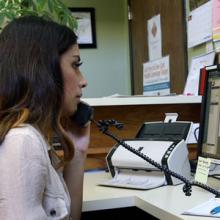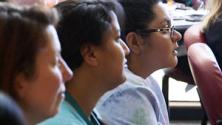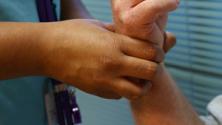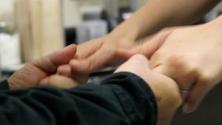Why is it important to rethink the role of the lay person?
The primary care team has long included lay people—people with no certification, licensure, or specific health care training. The most common examples of lay people in primary care are front desk staff and community health workers in safety net practices. But there are many other roles that lay people can play. When practices maximize the use of lay people, it allows team members with health care training to work at the top of their licensure and perform the work needed to keep patients following smoothly through the clinic.
How should the role of the lay person change?
At many LEAP sites, lay people are extensively and strategically involved in patient care. There are many roles lay people can play in primary care settings and on primary care teams, but most fall within three main categories:
- Patient-facing administrative roles, such as front desk staff, team administrative assistants, referral coordinators, and billing staff.
- Specialized administrative roles in areas such as quality improvement and health information technology.
- Specialized services, such as health coaching or serving as a liaison to connect patients with other resources in their community. Some of these services are currently provided by lay people called community health workers (CHW) or promotoras.
What do we gain by making these changes?
Maximizing the use of lay people in primary care brings the following benefits:
- Infusing the practice with fresh skills, knowledge, and insights from other industries and contexts that can help improve the quality of care and promote innovation
- Allowing more efficient use of resources so that staff with clinical training can work at the top of their license
- Opening up a larger pool of candidates to draw from to staff clinics
- Allowing leadership to hire based on attitude and then train new staff on specific topics or technical areas
- Boosting patient centeredness by integrating care team members who may have a deep understanding of local communities and ethnic groups
- Assess how you are using lay people in your practice.
Start by looking for opportunities to offload the work of licensed or certified staff to a lay person. It’s also helpful to consider areas where a non-health care perspective might provide fresh solutions. Editing by anonymous users seems to be enabled.
- Explore new roles your lay team members can play.
Here are some examples of new roles to try out with lay people in your practice.
Patient-facing administrative roles:
- Shepherding prior authorization forms through required processes.
- Helping with population management by reaching out to patients who may be overdue for lab tests or preventative screening tests.
Specialized administrative roles:
- Lay team members who have data analysis and/or project management skills are often well suited to lead quality improvement efforts.
- Lay team members who are adept with technology can serve as a liaison between the primary care team and the practice’s electronic health record (EHR) vendor.
Specialized patient services:
- Lay team members with strong customer service skills and knowledge of the local community can provide individualized health coaching for patients who need to make lifestyle changes. They can also help connect patients with community resources to address behavioral changes and psychosocial needs.
- Hire the right person.
Hiring a lay person allows for extra emphasis to be placed on an individual’s ability to work in a team environment and to focus on their interpersonal/communication skills, creativity, flexibility, and ability to be self-motivated. In addition, hiring individuals from the communities the practice serves may enhance the cultural competence and reputation of the clinic.
- Provide training.
Lay people may need training in clinical processes and/or medical terminology to function well in a primary care environment. Depending on their role, they may need specialized training in health information technology (HIT) systems and/or skills such as motivational interviewing. There are also a number of Community Health Worker and Promotora training programs that may include skills that are relevant to the lay people in your clinic. However, there is a great deal of variation in the definition and roles of CHWs, so it is important to carefully review these curricula.
- Provide a career ladder.
If you are able to successfully hire talented and creative lay people to join your practice, it’s important to think through possible career ladders in order to retain that talent.
Publications
Role featuresJob descriptions, career ladders and other HR materials
LEAP Learning ModuleOther helpful topics included in this website
Video
Staff trainingTutorials, training manuals, etc.
If you have a question about the improvements, action steps, or tools & resources in this module please let us know. We're here to help. And if we can't answer your question, we can probably connect you with someone who can.







